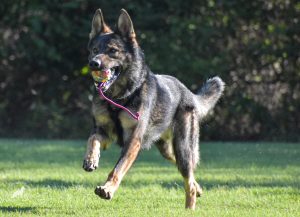Health Benefits of Working Line vs. the Show Line German Shepherd
1. Introduction
The German Shepherd Dog (GSD) breed, developed by Captain Max von Stephanitz in the late 19th century, has evolved into two primary subsets within the breed: working line and show line. Working line GSDs are bred for functionality, focusing on traits such as endurance, intelligence, and trainability, making them ideal for roles in police work, search and rescue, and military service. In contrast, show line GSDs are often bred for adherence to an external standard (the breed standard). Here at Czech Working Line we only breed the working line German Shepherd bloodlines. With our focus on health and active protection dogs, whether in the home or for law enforcement/military, only the working lines consistently meet these rigorous standards. With conviction we stay away from the extreme roach backs that so often lead to all manner of health issues. Continue reading for more reasons why our lines are arguably superior to the show lines.
2. Genetic Diversity and Health
The working line German Shepherd bloodlines benefit from greater genetic diversity due to their breeding practices. Breeders of working lines prioritize health and performance over appearance, often incorporating a wider gene pool to enhance these traits. This genetic diversity reduces the risk of hereditary diseases, which are more prevalent in show lines due to inbreeding for specific physical traits. Studies have shown that genetic diversity correlates with reduced incidences of autoimmune diseases and other hereditary conditions (Keller et al., 2011).
3. Hip Dysplasia and Orthopedic Health
Hip dysplasia, a common concern in German Shepherds, is significantly influenced by breeding practices. Working line GSDs tend to have a lower incidence of hip dysplasia compared to show lines. This difference is attributed to the rigorous health screenings and selection criteria in working line breeding programs, which prioritize functional conformation and joint health (Ginja et al., 2010). Additionally, the physical demands placed on working line GSDs promote stronger musculoskeletal development, further reducing the risk of orthopedic issues.
4. Exercise and Mental Stimulation
Working line German Shepherds require high levels of physical exercise and mental stimulation, which directly contribute to their overall health. Regular, intense exercise helps maintain cardiovascular health, muscle tone, and weight control, reducing the risk of obesity-related conditions. Mental stimulation, through training and work, prevents behavioral issues and cognitive decline, promoting overall well-being (Landsberg, Hunthausen, & Ackerman, 2013). Show line GSDs, while also benefiting from exercise, may not receive the same level of physical and mental challenges, potentially leading to increased risks of obesity and boredom-related behaviors.
5. Immune System and Resilience of the Working Line German Shepherd
The demanding roles of working line German Shepherds necessitate robust immune systems. These dogs are often exposed to various environments and pathogens, requiring a resilient immune response. As a result, working line GSDs tend to develop stronger immune systems through natural selection and adaptive immune responses. Research indicates that dogs with more active lifestyles and diverse exposures exhibit better immune health and fewer infections (Akhtardanesh, Zare, & Kheirandish, 2013).
6. Lifespan and Longevity
Lifespan is a critical health indicator, and working line German Shepherds often enjoy longer lives than their show line counterparts. The focus on functional traits and health in working line breeding programs contributes to this increased longevity. Studies suggest that dogs bred for performance and working roles live longer due to their robust health and genetic diversity (Borge et al., 2011). Conversely, show line GSDs, with their emphasis on physical appearance, may suffer from health issues that can shorten their lifespan.
7. Cognitive Function and Trainability of Working Line German Shepherd
Cognitive function and trainability are crucial for the roles performed by working line German Shepherds. These dogs exhibit higher levels of intelligence and problem-solving abilities, which are essential for tasks such as search and rescue, police work, and military operations. Enhanced cognitive function is linked to a variety of health benefits, including reduced risks of age-related cognitive decline and improved quality of life (Head et al., 2008). Show line GSDs, while intelligent, may not exhibit the same level of cognitive engagement due to their less demanding roles.
8. Temperament and Behavioral Health
Temperament differences between working line and show line German Shepherds also impact their health. Working line GSDs are bred for stable temperaments, with a focus on traits such as courage, confidence, and work ethic. These characteristics contribute to lower stress levels and better overall behavioral health. High-stress environments and behavioral issues can lead to various health problems, including gastrointestinal disorders and weakened immune responses (Casey et al., 2014). Show line GSDs, bred for conformation, may exhibit varying temperaments, potentially leading to increased stress and related health concerns.
9. Diet and Nutritional Needs
The dietary needs of working line German Shepherds are tailored to their active lifestyles. These dogs require nutrient-dense diets to support their energy expenditure, muscle development, and overall health. Proper nutrition is crucial in preventing health issues such as malnutrition, muscle wasting, and obesity (Freeman et al., 2013). Show line GSDs, with less demanding physical requirements, may not have the same stringent dietary needs but still benefit from balanced nutrition to maintain health.
10. Conclusion
The health benefits of working line German Shepherds compared to show line German Shepherds are evident in various aspects, including genetic diversity, orthopedic health, immune system resilience, lifespan, cognitive function, temperament, and nutritional needs. Working line GSDs, bred for functionality and performance, exhibit robust health profiles due to selective breeding practices that prioritize these traits. While show line GSDs are admired for their aesthetic qualities, their breeding focus on conformation can lead to increased risks of hereditary diseases and other health issues. For prospective owners seeking a healthy, active, and resilient German Shepherd, the working line variety offers numerous advantages.
Bibliography
- Akhtardanesh, B., Zare, P., & Kheirandish, R. (2013). “Comparison of innate immune response in healthy and leishmaniasis-affected dogs in southeast Iran.” Journal of the South African Veterinary Association, 84(1), 1-4.
- Borge, K. S., Tønnessen, R., Nødtvedt, A., & Indrebø, A. (2011). “Lifespan and cause of death in dogs: Influence of breed, size, sex and neutering status.” Acta Veterinaria Scandinavica, 53(1), 1-11.
- Casey, R. A., Loftus, B., Bolster, C., Richards, G. J., & Blackwell, E. J. (2014). “Human directed aggression in domestic dogs (Canis familiaris): Occurrence in different contexts and risk factors.” Applied Animal Behaviour Science, 152, 52-63.
- Freeman, L. M., Abood, S. K., Fascetti, A. J., Fleeman, L. M., Michel, K. E., Laflamme, D. P., … & WSAVA Global Nutrition Committee. (2013). “WSAVA nutritional assessment guidelines.” Journal of Small Animal Practice, 54(6), 385-396.
- Ginja, M. M., Silvestre, A. M., & Ferreira, A. J. (2010). “Diagnosis, genetic control and preventive management of canine hip dysplasia: a review.” Veterinary Journal, 184(3), 269-276.
- Head, E., Callahan, H., Cotman, C. W., Milgram, N. W., & Muggenburg, B. A. (2008). “A canine model of human aging and dementia.” Neurobiology of Aging, 29(3), 516-523.
- Keller, G. G., Burkland, L., Schuh, S. A., & Dziuk, E. (2011). “Adherence to screening protocols and the effect on hip dysplasia incidence in 16 breeds of dogs.” Journal of the American Veterinary Medical Association, 228(2), 175-180.
- Landsberg, G., Hunthausen, W., & Ackerman, L. (2013). Behavior Problems of the Dog and Cat. Saunders Ltd.
- O’Neill, D. G., Church, D. B., McGreevy, P. D., Thomson, P. C., & Brodbelt, D. C. (2013). “Longevity and mortality of owned dogs in England.” The Veterinary Journal, 198(3), 638-643.
- Ostrander, E. A., Galibert, F., & Patterson, D. F. (2000). “Canine genetics comes of age.” Trends in Genetics, 16(3), 117-124.
Sutter, N. B., & Ostrander, E. A. (2004). “Dog star rising: the canine genetic system.” Nature Reviews Genetics, 5(12), 900-910.




